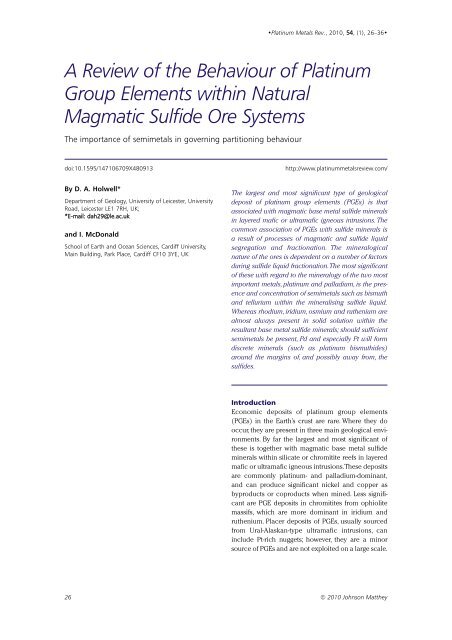Download Issue PDF - Platinum Metals Review
Download Issue PDF - Platinum Metals Review
Download Issue PDF - Platinum Metals Review
You also want an ePaper? Increase the reach of your titles
YUMPU automatically turns print PDFs into web optimized ePapers that Google loves.
•<strong>Platinum</strong> <strong>Metals</strong> Rev., 2010, 54, (1), 26–36•<br />
A <strong>Review</strong> of the Behaviour of <strong>Platinum</strong><br />
Group Elements within Natural<br />
Magmatic Sulfide Ore Systems<br />
The importance of semimetals in governing partitioning behaviour<br />
doi:10.1595/147106709X480913<br />
http://www.platinummetalsreview.com/<br />
By D. A. Holwell*<br />
Department of Geology, University of Leicester, University<br />
Road, Leicester LE1 7RH, UK;<br />
*E-mail: dah29@le.ac.uk<br />
and I. McDonald<br />
School of Earth and Ocean Sciences, Cardiff University,<br />
Main Building, Park Place, Cardiff CF10 3YE, UK<br />
The largest and most significant type of geological<br />
deposit of platinum group elements (PGEs) is that<br />
associated with magmatic base metal sulfide minerals<br />
in layered mafic or ultramafic igneous intrusions.The<br />
common association of PGEs with sulfide minerals is<br />
a result of processes of magmatic and sulfide liquid<br />
segregation and fractionation. The mineralogical<br />
nature of the ores is dependent on a number of factors<br />
during sulfide liquid fractionation.The most significant<br />
of these with regard to the mineralogy of the two most<br />
important metals, platinum and palladium, is the presence<br />
and concentration of semimetals such as bismuth<br />
and tellurium within the mineralising sulfide liquid.<br />
Whereas rhodium, iridium, osmium and ruthenium are<br />
almost always present in solid solution within the<br />
resultant base metal sulfide minerals; should sufficient<br />
semimetals be present, Pd and especially Pt will form<br />
discrete minerals (such as platinum bismuthides)<br />
around the margins of, and possibly away from, the<br />
sulfides.<br />
Introduction<br />
Economic deposits of platinum group elements<br />
(PGEs) in the Earth’s crust are rare. Where they do<br />
occur, they are present in three main geological environments.<br />
By far the largest and most significant of<br />
these is together with magmatic base metal sulfide<br />
minerals within silicate or chromitite reefs in layered<br />
mafic or ultramafic igneous intrusions.These deposits<br />
are commonly platinum- and palladium-dominant,<br />
and can produce significant nickel and copper as<br />
byproducts or coproducts when mined. Less significant<br />
are PGE deposits in chromitites from ophiolite<br />
massifs, which are more dominant in iridium and<br />
ruthenium. Placer deposits of PGEs, usually sourced<br />
from Ural-Alaskan-type ultramafic intrusions, can<br />
include Pt-rich nuggets; however, they are a minor<br />
source of PGEs and are not exploited on a large scale.<br />
26 © 2010 Johnson Matthey
















